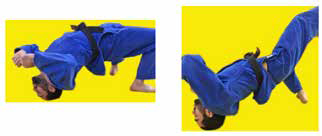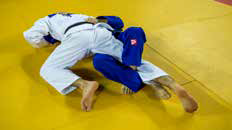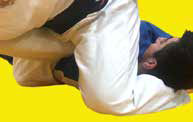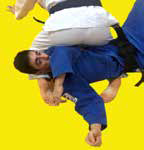Ref Training Program - The Rules (Articles 14-17)
- Details
- Last Updated on Sunday, 29 January 2023 01:06
- Written by Russ Scherer
- Hits: 9663
IV. The Rules (Articles 14-17)
Article 14 – Ippon
Scoring for actions that, without stopping, are a continuation of judo techniques. If there is a stop in the action, there is no score. Continuity, it is important that there is no interruption during the execution of direct throwing techniques, counter techniques, or combinations.
Evaluation of the points in nage-waza.
The four criteria for ippon are speed, force, on the back and skilfully controlled until the end of the landing. Looking at the line from shoulders toto the hips. Both must be at an angle that is a minimum of 90 degrees to the tatami to consider that there is a score, landing on the shoulder and upper back is considered a score.
1. Ippon will be given when the athlete throws his opponent on the back, applying a technique or countering his opponent’s attacking technique, with considerable ability with maximum efficiency (*). A judo technique which is present in the judo accepted repertoire (gokyo) must be identified. Just landing and rolling over and falling on the side/back in the process of the contest, without applying a clear technique, is not enough to score. It must be within the bounds of the published list of Kodokan judo techniques.
* “ikioi” = momentum with both force and speed and “hazumi” = skilfulness with impetus, sharpness or rhythm.
Rolling can be considered ippon only if there is no break during landing. The difference of the rolling makes the evaluation of the points. It is Ippon! when uke rolls on his back.

2. All situations in which one of the athletes deliberately makes a “bridge” (head and one foot or both feet in contact with the tatami) after having been thrown will be considered ippon.

This decision is taken for the safety of the athletes, so they do not try to escape from the technique and endanger their cervical spine. Also, an attempt of a bridge (arching the body) should be counted as a “bridge”.
No score or penalty will be given if the landing of uke occurs on the body of tori, in such a way that not all parts of uke’s body involving the bridge situation (head, foot or feet) touch the tatami.
Evaluation of the points in katame-waza
a) When an athlete holds with osaekomi-waza the other athlete, who is unable to get away for 20 seconds after the announcement of Osaekomi!.
b) When an athlete gives up by tapping twice (2) or more with his hand or foot or says Maitta! (I give up!) generally because of osaekomi-waza, shime-waza or kansetsu-waza.
c) When an athlete loses consciousness due toosaekomi-waza, shime-waza or kansetsu-waza.
Should one athlete be penalised with hansoku-make, the other athlete shall immediately be declared the winner with a score equivalent to ippon.
Special situations
a) Simultaneous techniques - when both athletes fall to the tatami after what appears to be simultaneous attacks and the referees cannot decide which technique dominated there should be no score awarded.
b) In the case where both athletes score simultaneous ippon the referee will act as regulated in article 13 paragraph 5.b.
Article 15 - Waza-ari
Scoring for actions that, without stopping, are a continuation of techniques. If there is a stop in the action, there is no score.
Evaluation of the points in nage-waza. The referee shall announce waza-ari (a near ippon) when in his opinion the applied technique corresponds to the following criteria:
Waza-ari criteria comprises landing on the whole side of the body at 90 degrees or more to the rear, or on one shoulder and upper bac. A score will be given for a whole side of the body landing even when the elbow is out. Hip and shoulder position must beconsidered. Everything that is out of this range won't get a score.
Landing simultaneously on two (2) elbows or hands or one elbow and one hand, towards the back, is waza-ari for tori and shido for uke.
When the four ippon criteria are not fully achieved.
These landings below are considered to be waza-ari.

In order not to give a bad example for young athletes, landing on both elbows or two hands, simultaneously, or one elbow and one hand is considered valid and should be evaluated with waza-ari and shido. In a golden score situation only waza-ari will be given by the referee.

• Landing only on one elbow cannot be used for assessment.
• Landing on the side of the upper body should be evaluated with waza-ari.
• Landing on one elbow, on the bottom or the knee with immediately continuation on the back will be waza-ari.
• Rolling can be considered waza-ari if there is a break during landing or the landing is on the side (bottom to shoulder or shoulder to bottom). The difference of the rolling makes the evaluation of the points it is waza-ari when uke rolls on his side or hips.
- Landing on the upper part of the shoulder should be evaluated with waza-ari.

These landings below are not considered to be waza-ari.

Evaluation of the points in osaekomi-waza.
a) When a athlete holds with osaekomi-waza the other athlete who is unable to get away for 10 seconds or more, but less than 20 seconds.
Article 16 - Waza-ari-awasete-ippon
Should one athlete gain a second waza-ari in the contest, the referee shall announce waza-ari-awasete-ippon (two waza-ari score ippon).
Article 17 - Osaekomi-waza
The referee shall announce Osaekomi! for an applied technique when the athlete being held:
- is controlled from the side, rear or on top by his opponent and
- has his full back or complete upper back (scapular region) in contact with the tatami.
The athlete applying the hold must not have his body orhis leg(s) controlled by his opponent’s legs either fromabove or from below the leg.
If the last situation happens after that the referee has announced Osaekomi! he shall announce Toketa!
The athlete applying the osaekomi-waza must have his body on and over the opponent’s body covering it and holding the opponent down underneath his body.
He must apply pressure onto opponent’s front upper body with his front upper body in either the kesa, the shiho or ura position, i.e. similar to the techniques kesa-kami-shiho-ura-gatame and sankaku situations.
Should an athlete who is controlling his opponent with an osaekomi-waza, change without losing control, into another osaekomi-waza, the Osaekomi! time will continue until the announcement of ippon (or equivalence), Toketa! or Mate!.
When osaekomi-waza is being applied and tori commits an infringement meriting a penalty (shido) the referee shall anounce Mate!, return the athletes to their standing positions and:
If the Osaekomi! time is less than 10 seconds, award the penalty then recommence the contest by announcing Hajime!.
If the Osaekomi! time is 10 seconds or more, but less than 20 seconds, award the penalty and the score (waza-ari); then recommence the contest by announcing Hajime!.
When Osaekomi! is being applied and uke commits an infringement meriting a penalty, the referee shall award the penalty directly by pointing at the uke without interrupting the contest with Sono-mama!.
However, should the penalty to be awarded be hansoku-make for tori or uke, the referee shall, after announcing Sono-mama!, consult with the IJF Supervisors and/or IJF Referee Commission, announce Mate! to return the athletes to their starting positions, then award Hansoku-make! and end the contest by announcing Sore-made!.
If an Osaekomi exists, but the referee has not announced osaekomi, the IJF Supervisors and/or IJF Referee Commission must inform the referee, who shall announce Osaekomi! immediately.
both table judges agree that an Osaekomi! exists, but the referee has not announced osaekomi, they shall inform the IJF Supervisors and/or IJF Refereeing Commission, and by the “majority of three” rule, the referee shall announce Osaekomi! immediately.
The IJF Supervisors and/or IJF Referee Commission, having consulted the CARE system, can quantify the exact time of the Osaekomi and communicate it to the referee for the relative decision.
The referee,after announcing Osaekomi! must not announce Toketa! in the presence of situations in which, for example, the back of the athlete being held is no longer in contact with the tatami, (e.g. "bridging"), but the athlete applying the hold maintains the initial control anyway.
If uke escapes from osaekomi-waza outside the contest area in the proximity of the limit of the contest area and no more than two metres:
- The referee must call Mate! if there is nNO immediate continuation from either tori or uke in applying osaekomi-waza, shime-waza or kansetsu-waza and, if the case, assign the relevant osaekomi-waza score.
- The referee must call Toketa! if there is an immediate continuation from either tori or uke in applying osaekomi-waza, shime-waza or kansetsu-waza, and, ifthe case, assign the relevant osaekomi score, leaving this last action to continue.
- If the osaekomi-waza action outside the contest area goes beyond the limit of the safety area the referee must call Ippon! Sore-Made!

This kind of osaekomi-waza is not valid and the referee must call Mate! if there is no progression in the action.


This kind of osaekomi-waza is not valid and the referee must call Mate! immediately.
It is never allowed to hold an osaekomi-waza just around the head/neck without control of at least one arm. Control in ne-waza using arms or legs around the neck without the opponent’s arm inside will be considered as Mate!.
2. U.S. Modifications and/or Comments
– example videos - 2016 Olympics M90kg - FRA-SWE Click HERE for examples of Osaekomi and not osaekomi shown at the 2020 IJF Seminar (Doha, Qatar)
**********************************************************************************************************************************************
Click HERE for video examples from the 2016 Ref/Coach Seminar in Tokyo - Tachi-waza scores - Ippon, Waza-ari
Click HERE for video examples from the 2016 Ref/Coach Seminar in Tokyo - Score vs. No Score
Click HERE for video examples from the 2016 Ref/Coach Seminar in Tokyo - White or Blue
Click HERE for video examples from the 2016 Ref/Coach Seminar in Tokyo - Score vs. No Control
Click HERE for video examples from the 2020 IJF Seminar (in Doha, Qatar - Waza-ari vs. Ippon
Click HERE for video examples from the 2020 IJF Seminar (Doha, Qater) - no score vs waza-ari
Click HERE for video examples from the 2020 IJF Seminar (Doha, Qatar) - score vs no score (continuation)
Click HERE for video examples from the 2020 IJF Seminar (Doha, Qatar) - score vs no score (control)
Click HERE to continue to the next training module
Click HERE to return to the INDEX.

